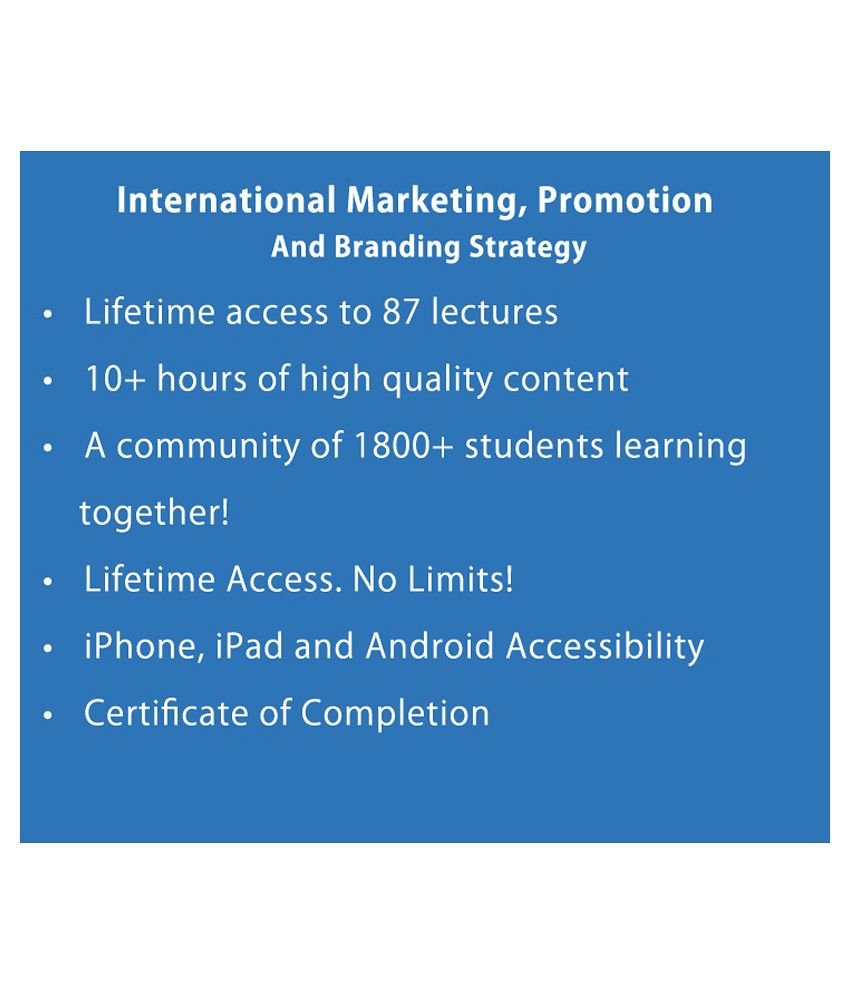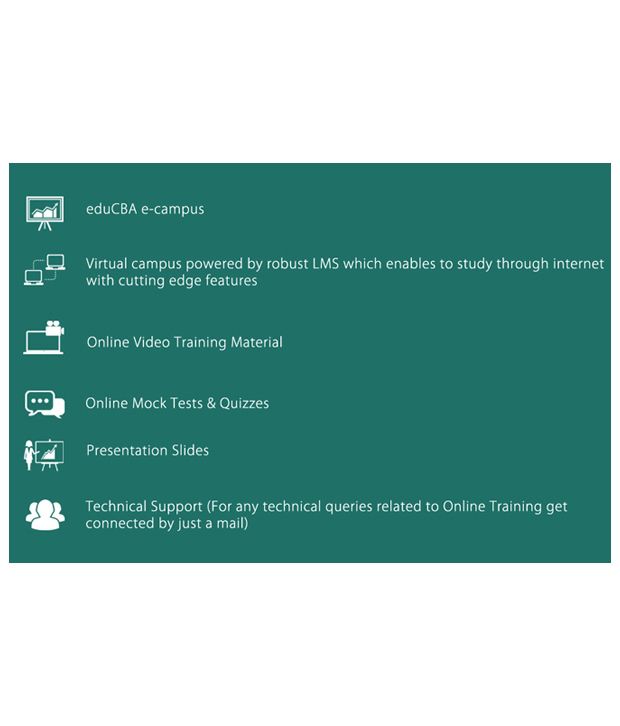![]()
Syste
m (Hardware/Software)
Requirements
| Operating
Software | Windows XP or
Higher
| | Processor | Minim
um P4 or Higher
| | RAM | 1 GB or
Higher
| | Browser | Any
| | Recommended Internet
Speed | Minimum 1MBPS
| | Supported Browser
Plug-ins | * Updated
Flash Player, * Update Java
| | Other
Requirements | Speaker or
headphone | |
Prdocut DescriptionWe will be covering the following modules in this course:
The International Marketing Phenomenon
International Measures and Conversions
The Scope & Importance of International Marketing
International Marketing Entry Methods
Researching Foreign Markets
Culture & Buyer Behavior
Governmental & Political Risks
Financial Risks & Currency Concerns
Organizing for International Marketing
International Distribution Strategy
International Product Strategy and Segmentation
Branding Internationally
International Price Strategy
International Promotion Strategy
International Marketing Strategy
Case Studies
Marketing is the process that allows you to direct your organization's goods and services to consumers in order to make a profit. The main difference between domestic marketing and international marketing is that the process takes place in more than one country.
International marketing involves recognizing that people all over the world have different needs. Companies like Gillette, Coca-Cola, BIC, and Cadbury Schweppes have brands that are recognized across the globe. While many of the products that these businesses sell are targeted at a global audience using a consistent marketing mix, it is also necessary to understand regional differences, hence the importance of international marketing.
The international market is incredibly diverse, providing business managers with untapped potential and a huge range of profitable opportunities. However, this diversity can make international marketing operations quite complex, requiring the coordination of a variety of processes in order to be successful. Organizations must accept that differences in values, customs, languages and currencies will mean that some products will only suit certain countries and that as well as there being global markets e.g. for BIC and Gillette razors, and for Coca-Cola drinks, there are important regional differences - for example advertising in China and India need to focus on local languages.
In most cases, the basic marketing principles are applicable to all markets around the world. The difference is that you need to be able to apply those principles in environments that could be significantly different to what you are used to dealing with. Many of the issues international marketers face are outside of their direct control, so theyneed to be prepared to adapt their strategies to cope with unfamiliar situations and problems. Just as the marketing environment has to be assessed at home, the overseas potential of markets has to be carefully scrutinized. Finding relevant information takes longer because of the unfamiliarity of some locations. The potential market size, degree and type of competition, price, promotional differences, product differences as well as barriers to trade have to be analyzed alongside the cost-effectiveness of various types of transport. The organization then has to assess the scale of the investment and consider both short- and long-term targets for an adequate return.
Some of the issues that can make international marketing difficult include the varying political, economic, cultural, technological and social situations experienced in different countries. As an international marketer, your task is to take the marketing elements that you have control over (research, product, price, promotion and distribution) and adapt them so that they work within your target market.
One of the most important factors to remember is that each market you enter is different. There is no guarantee that what works in one country or region will work in another. This is the reason that many international marketing attempts fail to achieve their desired results. The key to success is your market research and how you use it to effectively adapt your products and services.
Course Curriculum
Section1:Introduction to International Marketing
Lecture1:Terms in international marketing
Lecture2:Importance, Problems & International Perspective
Lecture3:Importance, Problems & International Perspective Continue
Lecture4:International Marketing Stages & Orientations
Lecture5:Domestic v/s International Marketing & Conclusion
Section2:International Trade Theories & Barriers
Lecture6:Merchantalism Theory
Lecture7:Absolute Advantage Theory
Lecture8:Comparative Advantage Theory Factor Endowment Theory
Lecture9:Product Life Cycyle Theory
Lecture10:Competitive Advantage of Nations Theory
Section3:International Trade Theories & Barriers
Lecture11:Levels of Economic Integration & Trade Barriers - Tariffs
Lecture12:Non-Tariff Barriers & Conclusion
Section4:International Market Entry Methods
Lecture13:Objectives of going international - proactive & reactive factors
Lecture14:Foreign market selection factors
Lecture15:International Market selection process
Lecture16:Exporting, Piggybacking & offshore Services
Lecture17:Licensing & Franchising
Lecture18:Turnkey operations, Management Contract, Contract Manufacturing
Lecture19:Strategic Alliance, Joint Venture, Wholly owned foreign subsidiary
Lecture20:Constraints to go international and conclusion
Section5:Researching Foreign Markets
Lecture21:Domestic v/s International Research and need for research
Lecture22:Research Objectives
Lecture23:The task of Marketing research
Lecture24:The task of Marketing research continue
Lecture25:Secondary data sources
Lecture26:Primary research in foreign markets
Lecture27:Primary research process
Lecture28:Primary research process Continue
Lecture29:Problems in international marketing research
Lecture30:Researching Foreign Markets Conclusion
Section6:Culture and Buyer Behaviour
Lecture31:Introduction to culture and cultural differences
Lecture32:Elements of culture - Language and Religion
Lecture33:Values & Attitudes, Manners & Customs, Aesthetics and Mate
Lecture34:Elements of culture - Education & Social Institutions
Lecture35:Sources of Cultural Knowledge
Lecture36:Cultural Analysis
Lecture37:Training and cross-cultural training methods
Lecture38:Consumer behaviour and culture with conclusion
Section7:Governmental & Political Risks
Lecture39:Home country & Host country Political Environment and Regulation
Lecture40:political risks
Lecture41:The legal environment
Lecture42:Jurisdictional Clause, Settlement of Disputes
Section8:Financial Risks & Currency Concerns
Lecture43:Exchange rates & Financial Instruments
Lecture44:Exchange Rate Implications & Exchange Controls
Lecture45:Exchange Rate Implications & Exchange Controls Continues
Section9:Organising for International Markets
Lecture46:Introduction & Unique problems of international organizations
Lecture47:Factors influencing International Marketing
Lecture48:Organisational Structure Alternatives
Lecture49:Human Resource Implications & Conclusion
Section10:International Distribution Strategy
Lecture50:International Distribution Channels & Levels of Distribution
Lecture51:Levels of Distribution
Lecture52:Factors influencing channel decisions and Distribution coverage
Lecture53:Types of Foreign Intermediaries & Channel Selection Decision
Lecture54:International Logistics, Warehousing in International Marketing & Conclusion
Section11:International Product Strategy & Segmentation
Lecture55:Product Part 1
Lecture56:Product Part 2
Lecture57:Product Part 3
Lecture58:Product Part 4
Lecture59:Product Part 5
Lecture60:Product Part 6
Lecture61:Product Part 7
Lecture62:Product Part 8
Lecture63:Product Part 9
Lecture64:Product Part 10
Section12:Branding Internationally
Lecture65:Branding Part 1
Lecture66:Branding Part 2
Lecture67:Branding Part 3
Lecture68:Branding Part 4
Lecture69:Branding Part 5
Lecture70:Branding Part 6
Section13:International Price Strategy
Lecture71:Price Part 1
Lecture72:Price Part 2
Lecture73:Price Part 3
Lecture74:Price Part 4
Lecture75:Price Part 5
Section14:International Promotion Strategy
Lecture76:Promotion Part 1
Lecture77:Promotion Part 2
Lecture78:Promotion Part 3
Lecture79:Promotion Part 4
Lecture80:Promotion Part 5
Lecture81:Promotion Part 6
Section15:International Marketing Strategy
Lecture82:Strategy Part 1
Lecture83:Strategy Part 2
Lecture84:Strategy Part 3
Lecture85:Strategy Part 4
Section16:Case Study on Starbucks Corporation
Lecture86:Case Part 1
Lecture87:Case Part 2
Benefits
eduCBA e-campus
Virtual campus powered by robust LMS which enables to study through internet with cutting edge features
Online Video Training Material
Presentation Slides
USP of the product
* 24 x 7 online access* Learn from tutorials curated by expert industry professionals and trainers* Certificate of Completion* Practical application oriented skillsHow to use? (Steps to use Study Material)
Step 1 - eduCBA sends the redemption coupon along with the registration link. Step 2 - Student will register with his register email id and coupon Step 3 - Student receive the course access and password on his/her email idStep 4 - Login using your email id and password and start learningTo get more information, you may want to watch the video below
Learn Everything, Anywhere, Anytime
India's Largest Online Education Marketplace




